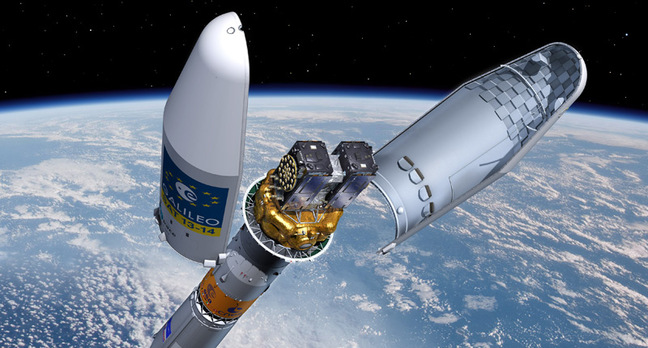As reported by GPS World: The Galileo satellite navigation system that will help Europe find its way in the 21st century now has 14 satellites in orbit after today’s double launch.
Galileos 13 and 14 lifted off together at 08:48 GMT (10:48 CEST, 05:48 local time) atop a Soyuz rocket from French Guiana.
This seventh Galileo launch went by the book: the first three Soyuz stages placed the satellites safely into low orbit, after which their Fregat upper stage hauled them the rest of the way into their target medium-altitude orbit.
The twin Galileos were deployed into orbit close to 23,522 km altitude, inclined 57.394 degrees to the equator, 3 hours and 48 minutes after liftoff. The coming days will see a careful sequence of orbital fine-tuning to bring them to their final working orbit, followed by a testing phase so that they can join the working constellation later this year. “Today’s textbook launch has added two more satellites to what has become Europe’s largest satellite constellation,” commented Jan Woerner, director general of ESA. “It was made possible by the fact that European industry’s manufacturing and testing of Galileo satellites has achieved a steady tempo.”
“Today’s textbook launch has added two more satellites to what has become Europe’s largest satellite constellation,” commented Jan Woerner, director general of ESA. “It was made possible by the fact that European industry’s manufacturing and testing of Galileo satellites has achieved a steady tempo.”
“Today’s launch brings Europe’s Galileo constellation halfway to completion, in terms of numbers,” remarked Paul Verhoef, ESA’s Director of the Galileo Program and Navigation-related Activities.
“It is also significant as Galileo’s last flight by Soyuz this year before the first launch using a customized Ariane 5 to carry four rather than two satellites each time – which is set to occur this autumn.
“Meanwhile, hard work is proceeding behind the scenes to ensure the worldwide Galileo system, including its far-flung ground stations, is reliable, secure and robust for the start of operational services to users.”
Full video replay of the launch is available here.
The launch was carried out from the purpose-built ELS launch complex at Europe’s Spaceport,. Total payload lift performance was estimated at 1,599 kg.
The flight had an early morning liftoff from the Spaceport – coming at precisely 5:48:43 a.m. French Guiana time. This Arianespace Soyuz mission was performed at the service of the European Commission, which is managing the Galileo program’s ongoing FOC (Full Operational Capability) phase. Design and procurement agent responsibilities have been delegated to the European Space Agency (ESA) on the commission’s behalf.
It is during the FOC phase that the Galileo network’s complete operational and ground infrastructure will be deployed. Today’s Soyuz mission — designated Flight VS15 — was Arianespace’s fifth overall carrying FOC spacecraft in sets of two. It follows one launch in 2014 (VS09), then three performed last year (VS11, VS12 and VS13). The medium-lift workhorse also lofted a total of four satellites in the program’s IOV (in-orbit validation) phase in 2011 and 2012.
The satellites orbited today — named “Danielė” and “Alizée” after winners of a European Commission-organized painting competition for children — are the 13th and 14th Galileo spacecraft overall to be orbited by Arianespace.
The spacecraft’s onboard payloads were supplied by UK-based Surrey Satellite Technology Limited (SSTL) — a company 99-percent owned by Airbus Defense and Space, which is an Arianespace shareholder, as well.
Israël acknowledged others that contributed to this latest Arianespace success, including State Space Corporation Roscomos and Russia’s industrial partners involved in the production and operation of Soyuz; along with the European support companies; the French CNES space agency; the ground contractors in French Guiana and Arianespace’s own teams.
Arianespace will conduct another launch for Galileo’s FOC phase later in 2016 — this time using an Ariane 5 and its heavy-lift capability to orbit a four-satellite payload. Two additional launches of the heavy-lift workhorse in 2017-2018 will bring total Galileo deployments to 26 spacecraft.





 The idea is to assemble an initial crew-tended habitat with pressurized work and living volume for the astronauts based on a Cygnus derived vehicle, and have it pre-positioned and functioning in lunar-orbit by 2020.
The idea is to assemble an initial crew-tended habitat with pressurized work and living volume for the astronauts based on a Cygnus derived vehicle, and have it pre-positioned and functioning in lunar-orbit by 2020.


/cdn0.vox-cdn.com/uploads/chorus_asset/file/6494959/Otto5.0.jpg)



 Other researchers looking at this question are interested in
Other researchers looking at this question are interested in 
